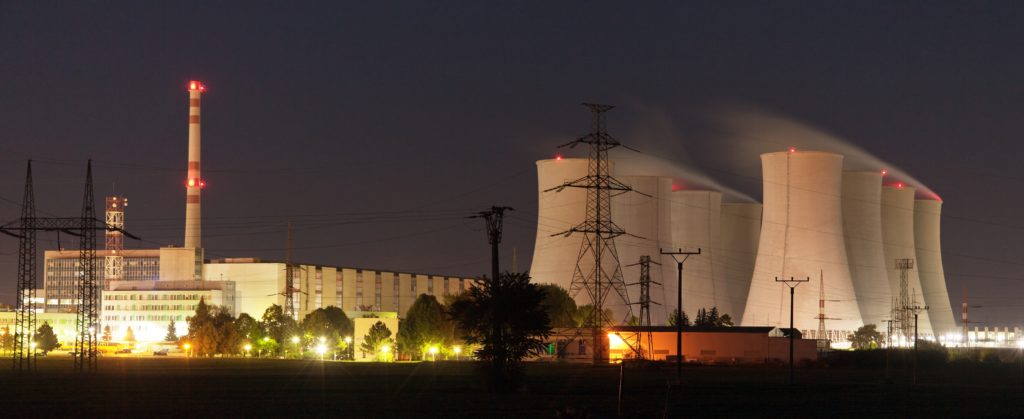
The beginning of environmental protection
Like nature conservation, modern environmental protection has emerged in North America. One possible reason for this region´s role as trailblazer is that the survivors of the indigenous people there, were able to preserve their animistic beliefs and to bring their holistic view of the world to the more peaceful settlers and their descendants. It is reported that chief Seathl “Seattle” of the almost extinct Suquwamish tribe in present-day Washington state, rejected in 1855 the appeal of the president of the United States, to sell tribal territories to white settlers, in words such as these: “If we do not own the freshness of the air and the glitter of the water – how could you buy them from us? … The earth does not belong to man, man belongs to the earth … We are a part of the earth, and it is a part of us … what affects the earth, will also affect the earth’s sons; Whatever happens to animals, happens soon to man too. All things are connected to each other. What man does to the earth, he does to himself”. One of the founders of modern environmental protection had already been interested in Indian culture at an early age, and as a student on the occasion of the lecture of an Indian, noted his following sentence: “Nature is the gateway to the Great Secret.” It was the German-American Aldo Leopold (1887-1948 ), who later, as a forester, hunter, game manager and naturalist had discovered, thanks to his intensive work in the wild, that the survival of species also depends on that of their natural habitat. Already in the twenties of the last century, he was one of the first to deal with ecology, which was almost unknown at that time, and called upon nature conservationists to consider its first findings. His thorough fieldwork had taught him, among other things, that only those who knew best about the relationships in nature, realized, how little they actually knew about it. His conservative attitude towards interference with nature, and his vehement rejection of the anthropocentric view of the world, which still prevails today, were built on this. Later he was inspired by the Russian philosopher Pjotr Uspenski (1878-1947), who saw the Earth as a whole and as a living creature, as well as by the great American writer and naturalist Henry David Thoreau (1817-1862). Both are regarded as pioneers of holistic or ecocentric ethics, which, in addition to all life forms, also assign all natural habitats their own values and, regardless of any benefits for humans, demands the protection and respect they deserve. Leopold developed his land ethic in this sense, in which he urged his contemporaries to no longer regard the land as their property in order to exploit it, but as a living community that includes them, in order to use it with love and respect. His book “A Sand County Almanac” was long time rejected by the publisher and therefore appeared only a year after his death. It was then celebrated by an interested audience and brought the first American environmental movement, which began in the 19th century, to a new peak after several decades. This created the basis for the subsequent environmental movement in the second half of the 20th century, which continues to this day, albeit with a modified objective. In North America, key thought leaders in environmental protection were motivated above all by the intense experience and feeling of largely untouched nature and their attentive observation in complete seclusion.

Most of them were outstanding personalities, who as foresters, naturalists and hunters spent a lot of time in the still wild nature of North America. By contrast, most European landscapes had lost early much of their natural primitiveness and wildness, due to dense human habitation and intensive use. The differences in landscape and the far less confined thinking of people from various cultures who came to North America and were freed from the social corset of the Old World, could be further reasons, why modern environmental protection first arose in North America.
Environmental protection as a political protest
The second environmental movement in North America was significantly influenced by the writings of the American author and zoologist Rachel Carson. She had worked for the US Department of Fishery for a long time and published many of her vast nature experiences in several scripts and non-fiction books. They expressed her slowly evolving ecocentric ethic, that was influenced by Leopold and other thought leaders. Four of her books made it to the bestseller list in The New York Times. Her greatest success was her book “Silent Spring”, published in 1962, in which she branded the devastating effects of pesticides on birdlife. Not only did this book shake up a number of bird friends among her readers, it also brought something of a revival experience to the American nature and environmental scene. At that time, great resentment had accumulated within populations in northwestern America over serious consequences of industrialization in forest areas that were difficult to access, which therefore had been preserved from destruction until then. The stumbling block there, was their partial clear-cut, often accompanied by landslides and fires in hitherto largely intact prime forests. Many people were horrified at that time, when the increasingly engineered wood industry was rapidly destroying huge forests for quick profits and growth, depriving numerous indigenous people and countless species of their livelihoods. In the American Northwest, people had changed the landscape particularly quickly and noticeably. Within just one generation, impressive forests with over ninety meters high and several hundred tons heavy tree giants gave way to desolate stretches of devastated land with tree stumps, transformed subsequently into species-poor steppes, bushes and building land. Modern transport, sawing and retrieving technology, as well as armies of lumberjacks in the rush of money, destroyed huge forest areas including its wild game stocks through large-scale clearing. The impact has been particularly dramatic for those indigenous people, who have always depended on the forest. In contrast, the deforestation in other areas of North America, had been spaced over generations, thus the people there could gradually come to terms with the transformation of forests into fields, pastures or building land.
The protests in America´s Nothwest increased, as indignant citizens joined the tribesmen affected over the destruction of nature. Added to this were numerous sympathizers of the emerging hippie movement as well as pacifists, who rejected the Vietnam War. When other US and Canadian war and nuclear power opponents appeared on the scene because of the planned US nuclear tests on the island of Amchitka near Alaska´s coast, the protest movement gained momentum. Out of this multifaceted merger arose the second American environmental movement. In it, the nuclear power opponents soon took the leading role. In 1969, the Friends of the Earth association was founded in San Francisco against the proliferation of nuclear power, allegedly with funding from Texas oil baron and anti-nuclear opponent Robert Anderson. It developed later to an internationally active network, which nowadays deals with a variety of environmental problems. In 1971, when a handful of journalists and a few nuclear opponents set out from Canada to Alaska with a ship renamed “Greenpeace”, thanks to funding by the charitable concert of Joni Mitchell, to testify to the controversial nuclear tests at Amchitka, the foundation was laid for the environmental organization of the same name. Although these activists could not prevent all seven nuclear tests scheduled at that time, they did succeed in avoiding further attempts there, thanks to a large public mobilized by some sympathetic media. This is how Greenpeace began its impressive development to become the leader of the pack within the world´s private environmental protection associations.
Unlike in America, the modern environmentalist movement in Europe was triggered in the first place by the energy crisis in the 1960s, polluted air, acid rain affecting forest, mass mortality of fishes and other chemical disasters.

As early as the fifties, individual authors had warned in Europe of environmental crises and their non-fiction books had met with great interest among critical readers. After the student-initiated revolt of 1968 broke out and the hippie movement blossomed, more and more young people, as well as young at heart, joined victims of environmental degradations, conservationists, anti-nuclear activists and pacifists in their protests in Western-oriented European countries against projects, that had a negative impact on the environment. Environmental protection was seen by many people as the contemporary alternative to the more conservative nature conservation movement. In 1970, the first Europe-wide environmental campaign started with countless events and acts in several countries. Since then, this so declared European Year of Nature Conservation, is considered the official year of birth of the modern environmental protection movement in Europe.
The first Green parties, which emerged shortly afterwards, usually as a spin-off from encrusted major socialist parties, had recognized the historic opportunity at that time and wholeheartedly subscribed to environmental protection. Their predominant political origins explain the mutual attraction between Green and Left parties until today.
Ethical relapse in environmental protection
The first environmental movement was strongly influenced by the deliberately antirational philosophy of romanticism and its glorification of nature. In North America, sympathy was gained by many descendants of white settlers for animistic religions of the Native American Indians. The influences of these two emotionally, respectively spiritually inspired holistic worldviews shaped this very nature-loving environmental movement, which united people from many social classes and age groups. They wanted to defend together the rights of endangered creatures as well as natural habitats and ensure their sustainable survival. When the second environmental movement emerged in the 1960s, the first concrete threats to humanity began to show up. Negative consequences of increasing industrialization, such as pollution of air, water and soil worried a part of the population in rich nations. Added to this was the new fear from those who were traumatized by the dreadful effects of nuclear bombs dropped on Japan, of the invisible danger of atomic radiation. Many citizens in North America and Europe were deeply concerned about atomic testing, as well as about nuclear power plants and nuclear weapons stationed in relative proximity to their homes. Fear for their own lives mobilized many of the followers of the second environmental movement.

Some followed it out of concern for their descendants over the risks of storing radioactive waste over millennia, a long-term challenge yet unsolved, that takes hostage many generations to come. The fears concerning one’s own survival and that of descendants, spreaded rapidly throughout the second environmental movement. This weakened considerably the selfless holism, which had inspired the initial environmental protection movement, for the benefit of the self-centered environmental ethic, aiming at first at the protection of its more egoistic supporters and their families. Since then, environmental protection has gradually moved away from its original ecocentric environmental ethics, and approached the selective anthropocentrism, that has since long ruled most of the world. The new environmental leaders’ quest for greater influence and their desire to obtain majorities for environmental protection, may have been the main reasons for their uncritical adoption of the risky techno-utilitarian attitude of anthropocentrism towards the natural environment. This attitude demands, that all things as well as other living beings have to serve people first and foremost. Accordingly, modern environmental protection focuses primarily on safeguarding those functions of the environment appearing as indispensable for humanity, such as those as air conditioning, water dispenser and food supply as well as such as storage for construction materials, as leisure or practice area and feel-good scenery for people. In practice, the vast majority of resources dedicated to environmental protection, flow into projects aimed at conserving the resources that are important to the inhabitants of the industrialized nations and at reducing harmful pollutants there. In line with its new, technical-utilitarian attitude, environmental protection no longer focuses on fighting the causes of human exploitation and destruction of the environment, but rather on the technical containment of its consequences, which may threaten people, mainly those in rich countries. Along the way, all creatures and habitats, to which the rulers of the industrial nations ascribe no particular benefit to their citizens, remain unprotected in reality. Besides the vast majority of animals and plants, as well as countless natural habitats, most people in developing countries are thereby denied effective protection and their continued exploitation with fatal risks is thus being accepted!
When the second environmental movement completely subordinated itself to the dictate of anthropocentrism, environmental protection took on the task of providing technical and legal framework conditions for an extended, although unsustainable growth of human society. Friedrich Engels, the former teacher of Karl Marx, had defined this goal long before, as the following quote from him documents: “In the future, the exploitation of nature should not stop, but human interventions in it should be rationalized in such a way, that their most distant effects remain controllable. This is intended to deprive nature step by step of the possibility of taking revenge on people for their victories over her ”(Fr. Engels, in: DialeKtik der Natur, quoted by SCHMIDT 1962, 134).
This objective was later expressed even more clearly in the directional document “Our Common Future”, published in 1987 by the United Nations World Commission on Environment and Development and named after its Norwegian chairperson, the “Brundtland Report”. In it, the economic compatibility of environmental protection and its primary focus on human interests were again invoked. A few years later, the then US President Bill Clinton hit the same line with his media-effective presentation of the “New Economic World Order”. Their particularly questionable direction for the future was packaged in the trendy slogan of “sustainable development”, which, despite its clear contradiction in terms, was received largely with benevolence to enthusiasm.
The instrumentalization of the environment
The purely technical-utilitarian attitude of modern environmental protection pays homage to a naive belief in progress, which remains stuck in old traditions of thought and has caused the ongoing pollution and destruction of the environment.
In doing so, this attitude relies blindly on self-confident scientists, who have set out to snatch their secrets from nature by researching quantifiable individual aspects in their respective fields of expertise. They act in stark contrast to the early naturalists, who were interested in the most diverse subjects and disciplines, and regarded nature with reverence, as the all-embracing unity. Furthermore, they act in oppostion to some principles of the logic, held high in other respects, at least by natural sciences. Apart from the fact, that logic can only grasp certain aspects of the environment, that are accessible to it, and that no logic of this world could explain, why only humans should have intrinsic values and a right to exist, logic requires enough information, to function properly. Otherwise, logic turns into speculation, which is simply irresponsible when dealing with life. In the context of the environment, the necessary information about other living beings and their relationships to each other is clearly missing. If one wanted to follow logic seriously, then any interference with the environment would have to be done with the utmost caution. In addition, the “logics” applied in a materialistic society usually follow expedient and superficial cost-benefit calculations. These are constantly adapted to the ever faster changes in the markets and the current state of information. As a consequence, “logic” has become a very changeable and elastic concept, that is hard to pin down. Furthermore, the widespread adherence of environmental protection to positions of scientists, who are in majority biased and intellectually arrested in their fields of expertise, contradicts the most important finding of ecology. This modern science states unequivocally, that even for itself as the competent science, it is impossible to grasp all relevant relations within nature in their complexity. However, since the research of ecology also relies on financing, it is as exposed to technical-utilitarian abuse, as other sectors of research. All ecologists, who do not submit willingly to the dictates of the anthropocentric worlview of the modern environmental protection movement, have few chances of pursuing their professional careers. Accordingly, ecology is far too little engaged in basic research and field studies, but increasingly occupied with computer simulations based on programmes provided by the recent cybernetic ecology. Their results, however, are less determined by reality, than by the choosen parameters and their respective weightings. Because of its dependence on available subsidies for research, ecology increasingly focuses on the metrological recording of global phenomena in the spirit of increasing instrumentalization of the environment. Thus, our extremely complex and altogether unfathomable natural environment, which is extremely complex because of its biodiversity and related functions, is reduced to an very simplified model as a lifeless and mechanistic object with few elementary functions.
In accordance with its new objective, the modern environmental protection movement is mainly concerned with the climate and the protection of air, water and soil in order to maintain processes that obviously are vital to human beings. For example, concerning forests, it is less concerned about preservation of their various ecosystems, than about their role in climate regulation, water balance and air quality. Although this seems to safeguard their most apparent values for human beings, the intrinsic values of the forests and of countless forest dwellers and living plants, as well as their rights to existence, are totally neglected in such approach. This example reveals, that modern environmental protection may eventually protect the future of human beings, but neither the quality of their life, nor the one of other´s species lives, or the survival of these.

What would forests be without the fragrance and splendor of various flowering plants, without the aerial acrobatics and concerts of various birds, and without the impressive sedulity and anatomical diversity of various insects, to name just a few of their numerous values, which apparently are´nt essential for the survival of mankind?
Since air and most of the natural bodies of water, which are in the focus of modern environmental protection, are even less bound to national borders, than far migrating animals, international cooperation is even more important for their protection, than in nature conservation. This is all the more the case, since environmental protection often affects very important interests of international corporations. For these reasons, environmental measures are usually negotiated at the highest political level. Regrettably, the concentration of decisions in environmental matters in the centers of power of nations and federations of states, rarely has positive effects on the natural environment. Indeed, decisionmakers usually agree to compromise on the last common denominator. In addition, where relevant decisions are made, well-established lobbying on behalf of influential companies, often sets the brakes. The recent history of modern environmental protection proves, that it usually only wins, if it does not jeopardize very important political and economic interests.
Moreover, the prevailing attitude of modern environmental protection relentlessly trusts an economy dating back to the nineteenth century, that has since the begin promised to heal the world of all evils through economic growth. Contrary to common sense, the economy detached from reality and fully committed to optimism, overlooks the finite resources of our world, which inevitably set limits to growth. Another problem is that this economy does not take into account the dramatically impacting environmental costs and the social costs of economic growth, which can not be objectively assessed and are ultimately burdened the general public through taxes and future generations as debts! As long as environmental protection retains its anthropocentric ethic, thus largely limiting itself to maintain those functions of the environment, which it considers essential for people, and to protect resources vital for them, more and more parts of it will get lost forever. Thereby, it accepts not only the ongoing impoverishment of the natural environment, but also unknown risks for many, if not most living beings.
The marketing of the climate
While the vast majority of poorer countries have more immediate priorities, than environmental protection, because of the ongoing struggle of their populations for survival, it is enjoying growing recognition in industrialized nations. Concern for the climate, especially that of the rich countries in the north, has grown steadily and is beneficiating increasing priority as industrialization progresses rapidly in densely populated emerging economies. Notwithstanding the disagreements among reputated climatologists, diverging over the question whether human-induced greenhouse gases, or cyclic fluctuations of sunspots are responsible for the current global warming, the increasing emissions of greenhouse gases are widely recognized as problematic.
Among the greenhouse gases, carbon dioxide (CO²) attracts the most attention, because in addition to that from natural sources such as most living beings, it is produced in the largest quantities by industry, agriculture, traffic etc. and emitted into the Earth’s atmosphere. As a first response to current global warming, significant emissions of greenhouse gases caused by human activities, including those of CO², are increasingly being monitored.
After a clear majority of public servants, leading companies and universities questioned in the US had spoken out against statutory limits for pollutant emissions and in favor of market policy instruments for their containment, a concept developed there in the 1960s for a trading scheme for atmospheric pollutants was revived, and implemented for the first time in the mid-nineties in a trading system for sulfur oxide (SO²) emissions under the National Program against acid rain. This concept is based on increased recognition of rights to pollute the atmosphere, which are being traded freely for more and more pollutants, and have been cleverly disguised under the trivial term of “emission certificates”.

Shortly thereafter, the United Nations Framework Convention on Climate Change (UNFCCC), under US influence, announced the quotas allocated to each member state for emissions of major greenhouse gases, and steps to reduce them with corresponding timetables, establishing in 1997 trading in such emissions as a flexible instrument to be used between member states.
Since then, international climate conferences have regularly been held with great media coverage. However, in addition to a totally unjustified optimism on the part of official representatives, persisting despite many missed intermediate goals, climate models and milestones contested by experts, as well as empty promises, they immediately produced more negative environmental impacts by intensified air traffic and waste of resources alone, than realistic solutions for the aggravating problems. This is no surprise, as the goals and procedures of this Convention are also prescribed by politicians from strong industrialized nations, who primarily represent the interests of their industries concerned, that support them. Unfortunately, these interests primarily serve to secure powerful positions and profits for a tiny minority, which hardly takes any account of other people and living things, or of their environment.
The marketing of the climate via pollution rights has beside its basic ethical problem, several weak points, which torpedo the alleged goals of climate protection. These problems start with the ways, how emission certificates are being issued:
On the one hand, these certificates are distributed by the governments of member staes to industrial companies there. Naturally, the weight and influence of companies play a certain role, even more so, since the allocation can be made free of charge, at least until 2030, and the permissible sale of surplus certificates, which have not been used, is likely to yield huge profits for the companies, which had received them before. As the allocation of allowances for emissions of the relevant pollutants are often based solely on reports made by interested companies about their former emissions, which are not counterchecked, the accuracy of this information, and thus the positive effect of such emission trading with regard to the targeted reductions of emitted greenhouse gases, is highly questionable!
On the other hand, these emission allowances are auctioned off and freely traded. Their auction favors interested parties among the more profitable companies, and thus leads to market distortions to the benefit of more potent companies, which undermine fair competition. In addition, the correct investment of eventual proceeds from auctions of pollution rights by the countries responsible for the compensatory measures to protect the climate, is not at all guaranteed. Added to this is the special appeal of auctioning and free trade in emission certificates for speculators. This has created a booming secondary market, often conducted via stock exchanges, which accelerates the drifting apart of unevenly distributed wealth, besides additionally increasing the climate-damaging consumption of energy and other resources.
The hope of realizing a global emission trading in the future, inter alia by linking the more than twenty relevant trading systems already existing worldwide, poses additional risks for the implementation of repeatedly weakened and deferred climate targets. A globally growing supply of allowances for pollutant emissions affecting the climate, can reduce their quality and prices due to less demand, and thus jeopardize the goals. In addition, the combination of different trading systems may require compromises, which further reduce the already very moderate climate goals. For example, the link with the largest offset market in the so called Clean Development Mechanism (CDM), has spilled a flood of credits from thousands of CDM projects onto the market. This offset market allows climate alliance member states to fulfill a large part of their climate related commitments, through their eligible investments in CDM projects from developing countries. Since those countries, where these investments go, only have limited numbers of CDM projects, it is in their interest to increase them, by listing as many as possible such projects. Similarly, the operators of these mostly industrial projects are interested in producing as many certificates as possible out of them for this market. These interests match in an ideal way with those of the northern industrialized nations committed to climate protection, who do not want to realize significant reductions of their own climate gas emissions, and at the same time want to avoid sanctions with the least possible investments. This will make win all economic and political stakeholders of this constructed trade in pollution rights. The costs of this economic win-win-story are at the expense of the global climate, the environment, the poorest countries, local small and medium-sized enterprises and all life on Earth. Many listed CDM projects bring no additional benefit for the climate, as they were planned anyway, and go hand in hand with huge destructions of nature and environmental pollution, which hit especially the people and creatures living there. The vast majority of CDM projects are situated in the industrialized emerging economies of India, Brazil, Mexico, Malaysia and especially in China, where almost all new hydropower plants and wind turbines are included in this program. Paradoxically, the fact that carbon tetrafluoride and hexafluoroethane, which are extremely damaging to the climate, is emitted during the manufacture of engines for wind turbines into the atmosphere, does not seem to bother much.
The costly application and processing of CDM projects, as well as the objective of obtaining as many and correspondingly lucrative certificates from them, favor large-scale industrial projects, and give no chance to sustainable small-scale projects, that benefit disadvantaged populations. The resulting discrimination, and the often lacking means of poor countries for technology transfers often crucial for setting up CDM-projects, hinder their participation in this highly acclaimed instrument for stopping the climate change, which also should explicitly serve their development.
To summarize, it has to be said, that the measures taken internationally on behalf of climate protection, primarily serve the purposes of entangled economic and political interests, instead of promoting a climate-friendly society and supporting development in poor nations. Nevertheless, it was possible to sell these measures against better knowledge to the public as highly successful and positive for the global climate, for which manoeuvre also lots of uncritical environmentalists could successfully be instrumentalized worldwide.

Mass manipulation in the name of climate protection!
Ever since the rapidly growing demand for environmentally friendly products, the economic opportunities related to environmental protection have been recognized. First of all, those products were in demand that, in addition to being eco-friendly, would bring health benefits to consumers, such as organic food, toiletries, cosmetics, detergents, bedding, clothing and furniture, all with as few chemical additives as possible. Soon followed services, capital goods and other product categories. Meanwhile, completely superfluous devices, accessories and luxury items are marketed with the help of flimsy environmental arguments. More environmentally friendly garments, bags, vehicles, cell phones etc. are increasingly used as signs of personal attitudes in the public, and supposedly environmentally friendly electric cars became trendy status symbols. This latest example illustrates how environmental protection is becoming a very effective marketing tool in one of the most profitable sectors of the economy, by targeting the particularly large and well-funded group of drivers in rich industrial nations:
The comparatively expensive electric cars are propagated as an important contribution to environmental protection, without fundamentally calling into question the mobility in private cars, which continues to increase even with available public transports. Thereby, several problematic aspects of electric cars are usually left out. These start with the exploitation of people and natural resources in poor countries, in order to obtain the raw materials needed for the production of the batteries for electric cars, and continue with unobserved emissions of pollutants and environmental depletions in the course of the extraction and generally long transports of the required raw materials. From the perspective of environmental protection, a very critically evaluated pollutant balance in the production of these batteries is to be added. Furthermore, until complete switching to solar energy and other, largely environmentally compatible sources of energy, such as hydrogen, the question arises, as to how the operating energy for electric cars is gained. Because all nuclear and thermic power plants cause serious environmental problems and risks, the construction of hydroelectric power plants is often associated with large-scale destruction of natural habitats and their operation fundamentally changes directly connected aquatic ecosystems. Wind turbines are also burdened with considerable disadvantages. In addition to affecting the attractivity of many landscapes and causing significant environmental impacts for building the necessary infrastructure, they are having a negative impact on wrong sites with numerous deaths of birds and bats, of which a major part belonged to endangered species. So far completely undervalued, is the use of the rare metallic earth neodymium needed for the production of wind turbines. This element is mainly produced in China at the cost of major environmental destructions, releasing radioactive uranium and thorium. Not enough, its further processing causes substantial emissions of very harmful greenhouse gases!

In addition, people in the industrialized countries consume the overwhelming share of the world’s electrical energy at the expense of all other humans on Earth. Electric cars are increasingly undermining the efforts for a reduction of the consumption of electrical energy, which is indispensable for a sustainable society. Adds to this the problematic and yet unresolved question of environmentally sound disposal of the potentially hazardous old batteries of electric cars. All this leads to the final conclusion, that emission-free electric traffic in industrialized countries is also paid with social, economical and ecological damages in the countries of origin of the raw materials, besides affecting the climate, which causes problems for many living beings worldwide. Nonetheless, electric car manufacturers have started to boost this profitable market, for which the demand has been artificially fueled in advance. The means of choice for this marketing campaign was the demonization of diesel fuel for private cars, orchestrated in the interests of the relevant industry with strong support from politicians and media, and initiated with selective bans for diesel cars in german cities. Ownership of a comparatively more expensive diesel car was guarantee enough for the necessary liquidity and financial solvency of the targeted customers for electric cars, and the former popularity of private diesel vehicles in many countries promised large sales of electric cars as trendy alternatives to it. This clever marketing strategy for promoting electric cars, reveals itself when comparing the relatively low proportion of pollutants that private diesel cars emit in total, with that of all other diesel engines in trucks, agricultural and industry machinery as well as in ships. The unmasking conclusion of this comparison is that diesel car owners are being punished, while the main responsible for diesel pollutants are supported in many places by discounted diesel purchase prices! This happens despite the fact, that reduced diesel prices artificially increase the demand for it, and decrease the motivation for taking measures to save this energy source in accordance with environmental protection goals, such as the long overdue transfer of freight traffic from road to rail. Considering that diesel cars require less fuel in comparison to gasoline cars, and therefore their emissions of the greenhouse gas carbon dioxide (CO 2) are lower than those of gasoline cars, that the nitrogen oxides produced by diesel engines and used as an argument for their demonization can be reduced with catalysts, and that diesel cars are usually disposed of and replaced much later, as cars running with gasoline, the negative score of diesel in their comparative assessment of environmental harmfulness propagated by the media, can be easily reversed. The dubiousness of electromobility ‘hyped’ over the banishment of very common diesel cars is further compounded by the fact, that the resulting price decline for used diesel cars leads to their mostly transcontinental and accordingly climate-damaging exports to poor countries. The utilisation of these used diesel cars there for decades, surprisingly disturbs no one despite its incompatibility with the environmental policy of the rich North, which organized their bashing. Notwithstanding any well-founded concerns, the on-going strategy towards electromobility has come to the fore: sales of electric cars are soaring, while sales of diesel cars are plummeting. Not surprisingly, the diesel car market slump creates the opportunity for another major business coup under the guise of environmental protection. Because diesel accumulates in large quantities during the production of gasoline, which until further notice is tolerated by environmental policy. Accordingly, the motivation of the oil industry to generate in good time lucrative sales markets in industrialized countries for the growing surpluses of large volumes of diesel withdrawn from automobile traffic is correspondingly high. A particularly promising market opportunity for many sectors of the economy could be created with technologically upgraded diesel heaters, which, marketed as a clean contribution to environmental protection, could displace the dirtier oil and wood heaters from many millions of households in the northern hemisphere.
Another example of misuse of the growing interest of the public in environmental protection concerns biofuels, of which the increased use in motor vehicles is intended to slow down global warming. This market offensive relies on the CO² neutrality of biofuels, due to their purely vegetable origin. This ensures that, when biofuels are burned in engines, only the quantities of CO² previously extracted from the air by the plants used as raw material, return into the atmosphere. Biofuels can be produced with diverse plant materials such as harvest residues, vegetable oils and specially grown energy crops. For alleged environmental reasons, biofuels shall increasingly replace the petroleum products gasoline and diesel, which is why the former are tax-advantaged and why the cultivation of energy crops for the production of biofuels is subsidized, as within the EU. Since most harvest residues are returned to the soil for sound reasons, they can not cover the raw material requirements for the production of biofuels. Therefore, the main problem of biofuels lies in the growing demand for agricultural land for energy crops, which is either withdrawn from the cultivation of food crops, or obtained through forest clearing. Switching over from petrol and diesel for cars in Europe to biofuels, would however require a multiple of all agricultural lands available there! Since this is impossible, the problem of the land requirement for “green fuels” from the industrial nations is quite unabashedly exported to developing countries. In addition, this saves high labor costs, because of the starvation wages there and furthermore increases the efficiency of production. Indeed, oil palms produce four times more biodiesel per hectare, than rapeseed, a common energy crop in northern countries. Therefore, much of the last natural forests in Indonesia, Malaysia and elsewhere will fall victim in the name of environmental protection to the sprawling cultivation of oil palms as energy crops. In the process, tree giants are felled and burned, some of which have stored carbon dioxide for centuries, which is then released into the atmosphere at once, considerably aggravating the impact of CO² emmissions on the climate.

When these clearings penetrate into marshy forests and the local peat soils are drained for the cultivation of energy plantations, the oxidation of peat causes additional releases of large amounts of CO2. All this has counterproductive effects on the internationally set climate goals. Even more worrying is the raging destruction of numerous natural ecosystems, which are among the richest in the world concerning biodiversity, with most of the living beings occurring therein, for plantations of energy crops in South East Asia. These are all consequences of the economic implementation of technical environmental protection goals of industrialized countries. In addition, they are responsible for the catastrophic, yet completely unnoticed misery of those, who are widely dependent on their natural environment, which is being systematically destroyed and exploited for the cultivation of energy crops.
Environmental protection needs a restart!
The biggest problem of modern environmental protection is its anthropocentric doctrine, which ultimately amounts to approving all environmental interventions with perceived benefits to humans. This momentous attitude is already contained in the presumptuous term “environment”, which separates humanity from its natural habitat and denies its own naturalness. This denial of one’s own nature diminishes the respect of the rest of nature and thereby endangers the livelihoods of the people. The term “environment” already emphasizes the humans´ self-centered position in the universe and its dominant rule over all non-human life and all inanimate things. They have been baselessly claimed since the advent of the monotheistic religions and were purposely supported by politics and sciences for their own benefit. Thus, modern environmental protection legitimizes the withholding of any intrinsic values and rights to liveable existence from all non-human elements of the environment, and reduces itself to safeguarding their recognized utilities for humans. It limits its efforts on the maintenance of processes and components of the environment, which are obviously essential for their survival. However, these are in turn dependent on other natural processes and components, and so on. If environmental protection really wanted to protect all the functions and parts of the environment that are vital to mankind, then it would logically have to protect also all those environmental factors, that either directly or indirectly safeguard the functions and components, on which humanity obviously depends. The more ecological knowledge becomes available, the more species and habitats would need to be included in environmental protection measures. But ecology is a relatively young science, and the limited research funding devoted to it, tends to flow into projects that serve the short-sighted interests of its financiers from the public and private sector. Accordingly, only a fraction of the essential ecological dependencies and environmental elements have been researched to date. In addition, the intellect and the senses of man naturally can never grasp all these natural processes in their unmanageable complexity. In the face of the acknowledgment by ecological science of its huge knowledge gaps, any environmental protection, which, contrary to any logic, confines itself to preserving only those environmental functions and elements, that are obviously indispensable for humans, inevitably becomes a very superficial gambling.
Taking into account ecological and physiological facts, the thorough examination of anthropocentrism ruling environmental protection exposes both it and its blind following modern environmental protection as risky illusions for humans and for most life on Earth. By renouncing to its original holistic viewpoint, refusing any intrinsic values and inherent rights to the entire environment and only caring for the preservation of its elements, that appear to be vital for humans, the protection of environment misses its proclaimed goals, loses its chance of saving both the environment as well as the future of humanity on Earth and thus, conducts itself ad absurdum! In the process, unlimited trust in technical solution potentials even entices committed environmentalists to a carelessness, that is also the cause of most of the environmental problems, they are fighting.
Ultimately, it is about a society that is compatible with our world and with realistic perspectives on a long and liveable future. This objective can only be achieved through an ethical renewal of environmental protection, conceding the environment and all of its natural elements their own intrinsic values and rights. Neither sciences, nor current religions want to or can offer this. The renunciation of environmental protection from its blind belief in progress and modernity as well as in the omnipotence of human intelligence, in favor of empathy and goodwill towards the environment is overdue. Only the natural bond with our world would guarantee the necessary caution and restraint, which would also protect our livelihoods from destruction, and all living beings from unnecessary violence by humans.

